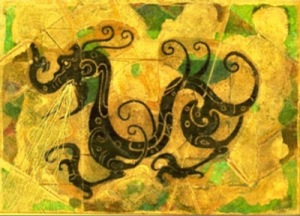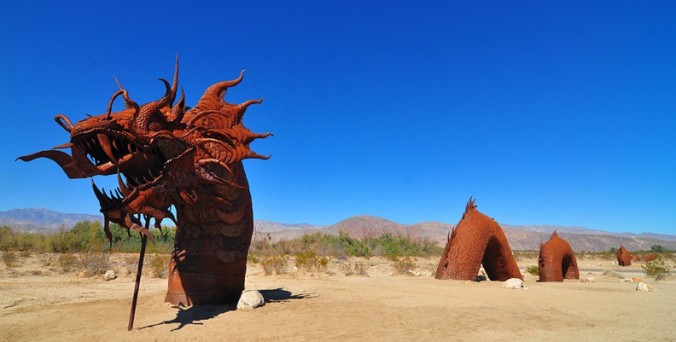Dragons are popular creatures, particularly in epic high fantasy. If you pick up a fantasy book at random, I’d say the chance of you encountering a dragon at some point during that book are high. In fact, doing a brief and highly unscientific survey of my fantasy shelf, I’d say about 15% of them involve dragons in some way (and i’m sure if I read exclusively epic fantasy that percentage would be higher). Personally, I’m not someone that actively seeks out dragons, but I always enjoy a well-wrought dragon when I encounter one.
The question is, when there are so many dragons out there, how do fantasy authors make their dragons feel fresh and interesting? How do they avoid presenting a beast that’s just a forgettable, tired cliché, and instead present a creature that is real and tangible and compelling? A creature that gives even jaded readers that feeling of wonder and delight?
Well, while I can’t claim to be a dragon expert, I thought I’d work with some of my observations, and refer to the wisdom of people more schooled in dragon-lore than I, to come up with a few ways fantasy authors can keep their dragons fresh:
1. Appearance
When you hear the word “dragon” you probably think you know exactly what to picture: large, dinosaur-like animal with wings and a tail and fiery breath. In vague terms, yes, that’s going to be accurate for most dragons. The thing is, if you look at the famous dragons that have been described in literature and brought to life on film, and put them all next to each other… well, you’d see how different they actually are. Take, for example, this size chart post on Whims from Valadae, which visually compares the sizes of several of the most beloved dragons in popular culture. It gives you an idea of how something as simple as the size can differ vastly from story to story.
The same goes for countless other little details – the colour and texture of a dragon’s scales (or fur, if it’s a dragon like Falkor from The Neverending Story), the way it breathes fire, the texture and thickness of its wings, the length of its neck. It’s those details that create a unique and memorable dragon, where a vague clichéd description will just melt into the stock-standard dragon everyone has lurking in their subconscious.
2. Mythology and Inspiration

Golden Dragon. Photo and artwork by Catherine L Mommsen (CC BY-NC 2.0)
Dragons prowled literature long before Smaug and The Hobbit arrived. The Anglo-Saxon poem Beowulf (coincidentally, a great inspiration to Tolkien), believed to have been written between the 8th and 11th Centuries, has the hero battling a dangerous treasure-hoarding dragon. Perhaps because of these two very famous and influential works, it’s very easy to think England when you think of dragons. It’s easy to think of knights and damsels in distress and castles.
However, as Deby Fredericks regularly points out on her dragon-focussed blog Wyrmflight, there are dragon myths and stories from many different cultures. There are shape-shifting Hawaiian water dragons, Tyrolian dragons that make mushroom circles, a tree root-chewing dragon from Norse mythology, a three-headed dragon from Arabian legend, and more. And in China, there are no less than nine different types of classical dragon.
I’m not saying a traditional English dragon is an uninteresting one… but if you’re looking to make your dragon more different and unique, why not explore some dragon myths from other cultures or lesser-know stories?
3. Personality
Unsurprisingly, dragons – and in particular the good dragons – are characters in their stories, and like any character, they have to be interesting if we are going to care about them. They may be self-aware beings, nearing or even surpassing human-like intelligence (for example in the Earthsea books or the TV show Merlin), or they might be more instinctive animal-like beasts, driven by rage or fear or greed or the need to survive. Regardless of where they fall on that spectrum, the dragons I find most interesting are always those that think or act in ways that are intriguing or unusual. Given they are invented creatures, authors have free-reign to make them think and behave however they like, to set unique cultural and social norms… and personally I think it’s always best when that free-reign is used to its full potential.
4. Make it Feel Real
This, for me, is one of the most important skills in dragon-making. If you fail to bring your dragon onto the page (or the screen) in a way that is visceral and real… well, you’re not giving it the chance to really fly.
Fantasy critic Lin Carter had a lot to say about making fantasy elements feel real, particularly dragons. He talked about fantasy elements needing to be made to feel solid, real and credible through use of homely detail.
“The careful use of precise, vividly realized, on-the-spot descriptive detail can work miracles in bringing to life on the page imaginary beings, fantastic scenes, supernatural events.” – Lin Carter, Imaginary Worlds
Just what kind of detail was he talking about? Well, he cited C.S. Lewis’s example of dragon “sniffing along the stone” in Beowulf, and also gave his own example of a dragon in Dunsany’s Carcassone that had caught a bear and “was playing with it, letting it run a little way and overtaking it with a paw.”

The Head of the Dragon – Metal Sculpture by Ricardo Breceda . Photo by Bill Gracey (CC BY-NC-ND 2.0)
I think these kinds of little details are the same ones that make us fall in love with a dragon like Toothless from How to Train Your Dragon. Toothless is an entirely fictional creature, yet the way he behaves and the sounds he makes can at times remind us of dogs, or cats, or other animals, and the little things he becomes fascinated or frightened by give him personality. Envisioning your dragon as a real animal, and using attentive or unusual details to bring it to life on the page, will make it feel like more than just a standard cardboard cut-out dragon.
“[…] it is not always enough just to put a traditional fire-breathing dragon into a yarn; in certain kinds of fantasy it is often most effective to rationalize your dragons, to envision exactly how they work, to visualize them within the story-context as if they were actual zoological specimens encountered amidst a genuine landscape.” – Lin Carter, Imaginary Worlds
5. Don’t Be Afraid to Challenge Stereotypes
Just as in all writing, sometimes it’s the new or different thing people choose to do with traditional narrative elements that make their stories appealing. The same goes for dragons. Do dragons always have to be treasure-obsessed? Do they have to be wise? Do they have to breathe fire? Do they have to have scales? Do they have to have long teeth? Do they have to be invulnerable and hard to kill?
Maybe for you, they do, and that’s fine. Obviously if you stray too far from the notion of what makes a dragon a dragon, people may have problems with you classifying it as such. Still, I believe that doing something unusual with your dragon will make people more inclined to remember and be fascinated by it… maybe even fall in love with it.
A few dragons that stick out in my mind because of their more unusual traits:
- Falkor, The Neverending Story – the lucky, furry dragon
- Toothless, How to Train Your Dragon – literally toothless, young, small, inexperienced… and incredibly cute
- The dragons in Harry Potter – not so much for their individual personalities as for the multiple breeds that exist and the way they are bred and kept captive by wizards, and often treated cruelly (e.g. the trapped tortured dragon in Gringotts bank).
- Kilgharrah, Merlin – because of his tenuous relationship with Merlin. At times he appears to be a wise helper and teacher, and at others a destructive murderous creature that lays siege to everything Merlin holds dear.
_____
But of course, opinions vary. Here are some favourite dragon lists compiled by other fantasy fans:
- Who is the Greatest Dragon? – Amanda Hocking’s Blog
- Here be dragons: the most noble of literary beasts – The Guardian
- Here Be Dragons! Some of Our Favorite Fantastical Fire-Breathers – Tor.com
And some interesting articles about dragons in general:
- HERE BE DRAGONS – Welcome Collection Blog
- Picturing Dragons – Tor.com (a collection of 170 different drawings and paintings of dragons)

Brilliant post!
The multi-headed dragons in the Arabian legend are intelligent beings, when you cut one head off another one pops in its place. Dragons in the Arab fairy tales are quite different from the Anglo-Saxon dragons. I think Chinese dragons merit some research, too. Though I don’t use dragons in my work, I think they are overused in fantasy and it’s time to explore other alternatives.
LikeLiked by 1 person
Pingback: Best fiction and writing blogs | M.C. Tuggle, Writer
These are very useful suggestions. The trick is always to know when to use certain conventions to help the reader relate, and when to tweak those rules to make your work unique.
LikeLiked by 1 person
Great tips on making a common element unique and interesting. Thanks for the post.
LikeLiked by 1 person
This is a great article. Thanks for including me. So much about dragons as characters depends on what the author needs to do with them. That is, are they helpers, enemies, loose cannons? Who is the audience and what are their expectations? As you say, whenever I have dragons in my story, I look for interesting new wrinkles to keep them fresh.
LikeLiked by 1 person
Pingback: Dragon Encounters 8 | Wyrmflight
Gosh, this blog has literally everything.
My fantasy books are barely fantasy and my dragons are dinosaurs.
See my post about it here https://outofbabel.com/2019/01/25/dinosaurs-in-history/
LikeLike